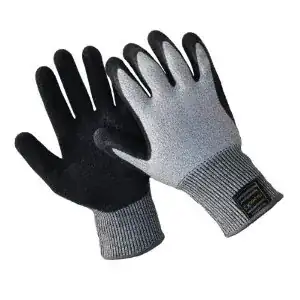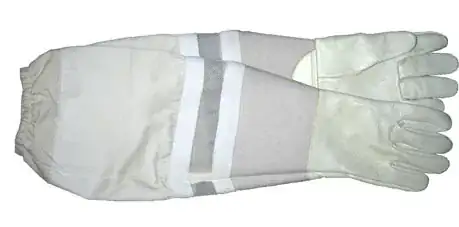I have a couple of rose bushes in my new house and the thorns in the bush (there are a lot of them!) go right through my current gardening gloves, and they hurt. what kind of gloves are available that will prevent rose bushes from stabbing my hands?
-
1What kind of gloves are you currently using? just the soft cloth garden gloves? – wax eagle Jun 28 '11 at 15:25
-
@waxeagle - I am using cloth gloves with a rubbery kind of coating - kind of like these - http://www.biofloris.com/media/catalog/product/cache/1/image/5e06319eda06f020e43594a9c230972d/m/3/m300-gloves.jpg – Moe Jun 28 '11 at 15:27
-
good deal, I almost suggested some of those before I thought better of it. – wax eagle Jun 28 '11 at 15:32
-
1yea I'm not surprised - they wouldn't protect against my cacti. I'd suggest some good leather gloves along the lines that @waxeagle or myself have suggested. – winwaed Jun 28 '11 at 15:40
-
@Moe: These kind of gloves are good for soil and general dirt. They don't don't take thorns very well. – Ambo100 Oct 07 '11 at 13:34
7 Answers
I don't have much experience with roses (just planted my first bush this year), but it seems to me that you have two options when dealing with thorns.
Good leather gloves, or consider a specialized product like garden armor. Leather gloves are harder to penetrate.I have not used garden armor, but they appear specifically designed to do exactly what you want them to.
- 5,148
- 6
- 34
- 70
-
1I got leather gloves, I didn't think they would be good enough, and I was expecting to need to return them - but they did the job. – Moe Jul 05 '11 at 00:19
For a different idea...
I hate buying gloves and having them fall apart all the time. (I'm rough on gloves. Even the expensive ones split apart quickly when you're moving wood, rocks, or doing a lot of digging.)
Call me a cheapskate, but I buy the cheapest gloves I can find (e.g. these US$2 work gloves). Then I wrap a layer or two of duct tape (heavy duty -- the good stuff) around the fingers, and a layer or two around the palms. Don't wrap too tight or they'll be uncomfortable (it's best to have a helper wrap your gloves while you're wearing them).
They're durable, easy to repair, and provide good protection against thorns. As winwaed says in his answer, there is a tradeoff between comfort and protection. I have a pair with only finger reinforcement that I use for shoveling or moving wood or rocks. If I'm going to pull out a bunch of blackberries, I'll use something with palm reinforcement.
You might use an extra layer of tape if you find the thorns penetrating a single layer.
Three cheers for duct tape!
- 41,452
- 7
- 111
- 235
There is going to be a trade off between comfort and thorn resistance. At the thin end (which you are probably using) are the thinner gloves. These would include fashion gloves ("ladies gardening gloves"), and the cheap barely-a-whole-hand glove which are great for lifting timber, bags of gravel, etc. but give little protection for spines, nails, etc.
Next up there are heavy duty gardening gloves which are made of a thicker suede-like/leather material. Usually these are longer and give some wrist protection. They cost more - perhaps as much as 5x the price of the cheap ones. These might be sufficient - I find they're good enough for the better behaved cacti.
The full solution (which I haven't tried) would be to go for proper welding gloves. These are thick leather affairs. They're not going to be as comfortable - possibly oppressively so in a hot, humid climate; but they'll protect against a lot. Their thickness is really for thermal protection but it is a thick dense material rather than oven glove "fluff".
Although I've never handled a pair, I understand falconry gloves are similar to welding gloves - clearly here the protection is against spikey things (talons and beaks) rather than heat.
- 20,373
- 4
- 61
- 115
-
4It would be totally awesome to weld with one hand while holding a falcon with the other - and you would only need one pair of gloves! – Moe Jun 28 '11 at 15:50
-
I wouldn't use welding gloves for gardening. I loose a lot of dexterity when I wear mine - but then again they were just about the cheapest ones out there. You might be on to something with the falconry gloves though. – Doresoom Jun 29 '11 at 18:53
-
Yes they're not the most flexible, but as I say I think there's going to be a tradeoff between comfort and thorn protection. – winwaed Jun 29 '11 at 18:57
I'd recommend something like a puncture resistent glove that's much stronger than leather (the page says 4 times). This is also ergonomically designed, so you won't have much discomfort.
These are most often bought by people who cut their fingers on the kitchen slicers. So while it's not really a "gardening glove", I see no reason to not use it as one. Also, it's pretty inexpensive at $14.

- 11,099
- 7
- 55
- 92
I kept bees a long time ago and I often wish I'd kept the kit because I miss those long gloves.
Beekeepers need protection while also needing a glove which allows careful and precise hand movements. Typically their gloves go right up the arm.

Beware, though, beekeeping kit isn't cheap.
- 9,513
- 12
- 47
- 113
The gloves I use don't really protect from thorns all that well, but I find that if you handle roses by grabbing them right near the flower itself, you don't encounter many thorns.
- 263
- 2
- 4
i've had good luck with insulated leather gloves and my hands don't feel especially uncomfortable on a 100° day. barberry thorns are thinner and impossible to avoid. they go through the leather occasionally; and once it's happened, it will happen more frequently in the same spot. 'thought about adding some duct tape to the grip areas......un-insulated are no good for thorns; insulated suede are okay but not as good. i will not use rubber or plastic dipped for thorn-work again. that was painful! doing some research, i now see why. they are "cut" or "slash" resistant because they're woven with resistant materials; but thorns will travel in-between the weaves. the coating itself offers little protection,it seems........it may help to note that rose thorns point inward -wild (invasive)multi-flora even more so; so if you can avoid sticking your arm in you may avoid getting sliced. i often use a short pole-pruner to clip toward the base of the stem, (such as this 5' one: http://cdnll.gardenersedge.com/images/500/9234_1.jpg )then pull it out by the tip of the branch. i may have to make a few cuts because of cross-branches, but it's still easier than going against the direction of the thorns.(& safer)......i am considering trying these: http://www.magidglove.com/assets/item/hero/TRX550_HERO3.jpg
- 31
- 2